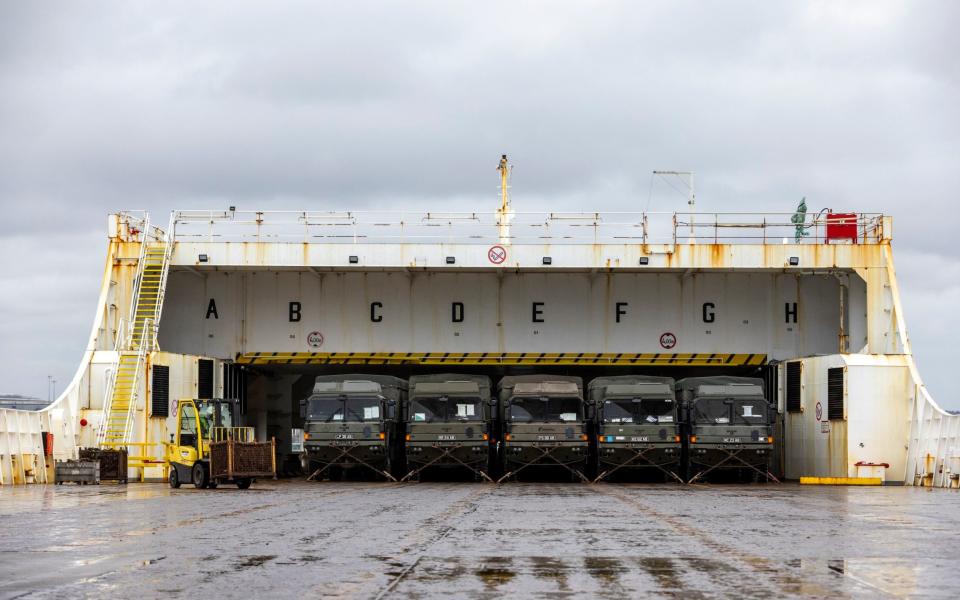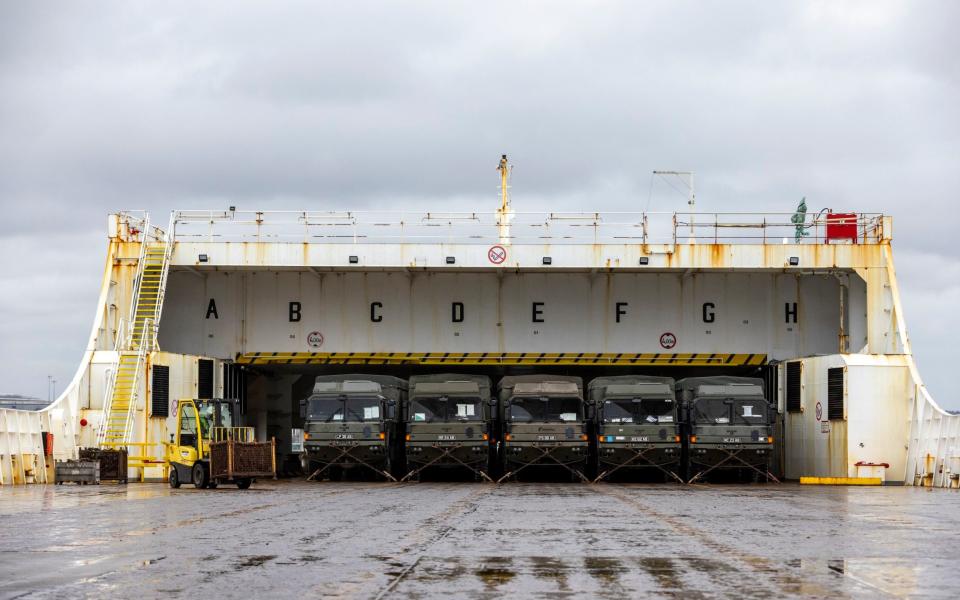Yesterday afternoon the Iranian-backed militia in Yemen, the Houthis, claimed they had targeted four ships which they deemed to belong to the US/UK/Israel “trio evil”. According to the rapidly becoming famous Houthi spokesman Yahya Sare’e – the Comical Ali of the 2020s – “the British landing ship Anvil Point” was targeted and “the hit was accurate and direct. The ship was targeted by a number of cruise missiles.”
That would be big stuff if true. A “landing ship” would usually be an amphibious assault ship, a naval unit. The Houthis are claiming to have hit a Royal Navy warship with several missiles.
However we need to remember that according to Yahya Sare’e the US aircraft carrier Dwight D Eisenhower, now happily on her way home to the States, was apparently hit and sunk at least three times during her recent deployment in the seas off Yemen.
But Anvil Point does exist, and does spend most or all of her time working for the UK Ministry of Defence (MoD), though she doesn’t belong to the Royal Navy nor even the supporting, civilian-manned Royal Fleet Auxiliary.
Anvil Point isn’t a “landing ship” able to put troops and equipment ashore without a harbour, but an ordinary roll-on/roll-off merchant ship. She is one of six purchased in a UK government Private Finance Initiative (PFI) deal of 2002, in which commercial investors built the ships and the Ministry of Defence committed to a long-running charter deal that would see the investors recoup their outlay with a pretty much guaranteed profit. The crews are British merchant seamen with reservist status so that they can be sent to warzones: but they aren’t Royal Navy sailors or even members of the Royal Fleet Auxiliary, tasked in support of the RN. These crews are the auxiliaries to the auxiliaries, as it were.
None of the claimed Houthi strikes appear to have happened, though Anvil Point has been in the area. The MoD’s inability to put out a statement reassuring the families of those embarked is due to its institutional sluggishness and nothing else. Eisenhower’s captain got round this issue by posting videos of jets taking off after each ‘attack’, or pictures of the ship’s dog, thereby immediately countering the false Houthi narrative. Whatever has happened to Anvil Point, we need to be much sharper in this space.
These Point class ships are critical to UK strategic ambition and were a far-sighted scheme to reduce our dependence on Ships Taken Up From Trade (STUFT) which may or may not be available when you most need them. At 23,000 tons displacement and 193 metres long a Point class ship can carry 130 armoured vehicles, 60 trucks with ammunition or 8000 tons of normal vehicles.
By contrast the Antonov An-124, the world’s largest military cargo aircraft, can haul a measly 150 tons. The MoD used to charter Antonovs quite often, at half a million pounds a day. At one point they were actually preferred over the RAF’s handful of heavy transport planes: the RAF were unwilling to fly into Afghanistan as their aircraft didn’t then have flares and defensive aids fitted. Neither did the Antonovs, but the charter pilots didn’t care.
In theory the MoD could still keep chartering Antonovs: the Antonov design bureau is based in Ukraine, much of the planes’ manufacture took place there, and Ukraine received a fleet of Antonovs in the partition of the Soviet Union. Five Ukrainian An-124s survived the Battle of Hostomel Airport during the Russian invasion attempt of 2022 and nowadays operate commercially from Germany. But as we’ve seen, sea lift is the only way to move serious land forces: ships, not aircraft, are what gets the heavy lifting done.

Going back to the Point Class we find that they are owned by Foreland Shipping, managed by AWShipping Management and leased to the MoD, and they sail under a UK flag. The Point Class aren’t, as the grey-hulled Royal Fleet Auxiliary vessels are, being assigned to carry out increasingly warship-like tasks, but they are suffering many of the same age-related fragilities and overstretch as the RFA. Courtesy of their green and white hulls they are even less well known among the UK public, if that’s possible.
These ships are on the go year-round, supplying and supporting our overseas bases such as the Falklands (every six weeks), Gibraltar, Diego Garcia and Bahrain. They have been used in major overseas exercises such as Saif Sareea (Oman 2018) and the Cougar series from 2011 to 2018 and were also used ‘for real’ during events like Op Pitting, the evacuation from Afghanistan.
So they are important strategic assets and, safe to say, occasionally carry cargoes of interest. All of which begs the question, why is one of these operating anywhere near Yemen without protection? I’ve written any number of times that you can’t compare the risk of operating an aircraft carrier there to, say, the sinking of the Moskva in the Black Sea. The latter only happened because Russia was stupid enough to send a High Value Unit (HVU) inside a known threat envelope without layered defence in place.
Oh, wait …
Meanwhile, USS Eisenhower is returning home after eight long months providing leadership and striking power. Her replacement, the USS Theodore Roosevelt, won’t be there for weeks if not months. Houthi missile forces can operate with near-impunity in the meantime. The US Navy really is an eleven-carrier navy in a fifteen-carrier world.
Of course, not to throw too many stones, neither of the British carriers are there either and HMS Diamond, our Type 45 destroyer which has been operating in the area – an ideal ship to cover Anvil Point – is heading home, also after a successful combat tour in the Red Sea. Her replacement, HMS Duncan is also not there yet. Three other British destroyers are in maintenance. Our forward-deployed frigate is alongside in Bahrain. And so on.
As well as disrupting international shipping for its own sake, other Houthi desired end-states include improving their regional standing and stretching coalition resources. This last one is what we are now seeing and the reason Anvil Point is operating without any escort cover.
Zoom out further and we can see that almost everything except people comes to and goes from this nation on or under the sea: whether it’s goods, energy or information. Often the sea in question is not near UK shores – much of our trade moves through chokepoints like the Bab-el-Mandeb, just off the Houthi-controlled Yemeni coast. Our ability to control the sea and protect our vital arteries is terribly, terribly weak.
Normally I would say, “and this before the shooting even starts” but now, of course, it has. I’m not only talking about building more warships here, nice though that would be: I mean the whole thing, from shipbuilding infrastructure to maritime education to recruiting to maintaining a list of ‘ready reserve’ mariners who could be called up in the event of war. The Integrated Review and the National Ship building Strategy have elements of this in them, but both now need to be resourced and accelerated.
Rob Johnson, who recently stepped down as director of the MoD’s Office of Net Assessment and Challenges summed it up thus: “The UK has reached a situation where it cannot defend the British homelands properly.”
Meanwhile the present Foreign Secretary, whose decisions as Prime Minister from 2010 onwards had much to do with us being in our current unfortunate position, is now lecturing other nations on strengthening their defences. The chutzpah is breathtaking.
One hopes that the draft agenda for the day after the election has “Maritime Security” somewhere near the top. Rubber boats will be there but the conversation needs to go much, much further. The cost of doing this cannot be ignored but should be discussed alongside the cost of not doing it, which is potentially a much, much bigger figure. History tells us what that looks like and it reveals plans like “increasing defence expenditure by half a per cent when conditions allow” as short-sighted. This is where we are now.
And in the meantime free goods, such as not letting our adversaries constantly steal the narrative, should be addressed. While I was writing this, my colleague Peter Sandeman of the excellent Navy Lookout website kindly called AWShipping management. They have confirmed that Anvil Point is just fine. It took him two minutes. A statement saying “Anvil Point has not been struck by Houthis” would take another one minute.
Why is this so hard?
Tom Sharpe is a former Royal Navy officer and warship captain. He also served as the RN’s top press officer in the MoD, and today works in strategic communications
EMEA Tribune is not involved in this news article, it is taken from our partners and or from the News Agencies. Copyright and Credit go to the News Agencies, email news@emeatribune.com Follow our WhatsApp verified Channel





